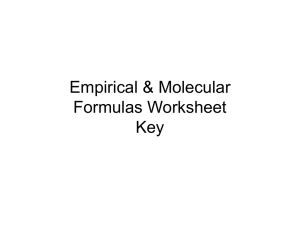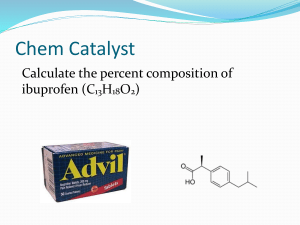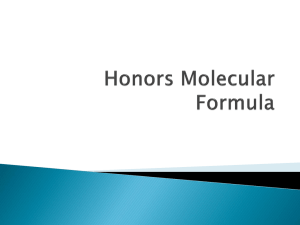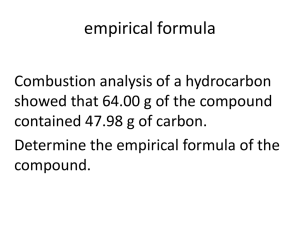S. 5.5 – Empirical and Molecular Formulae. Empirical Formula
advertisement
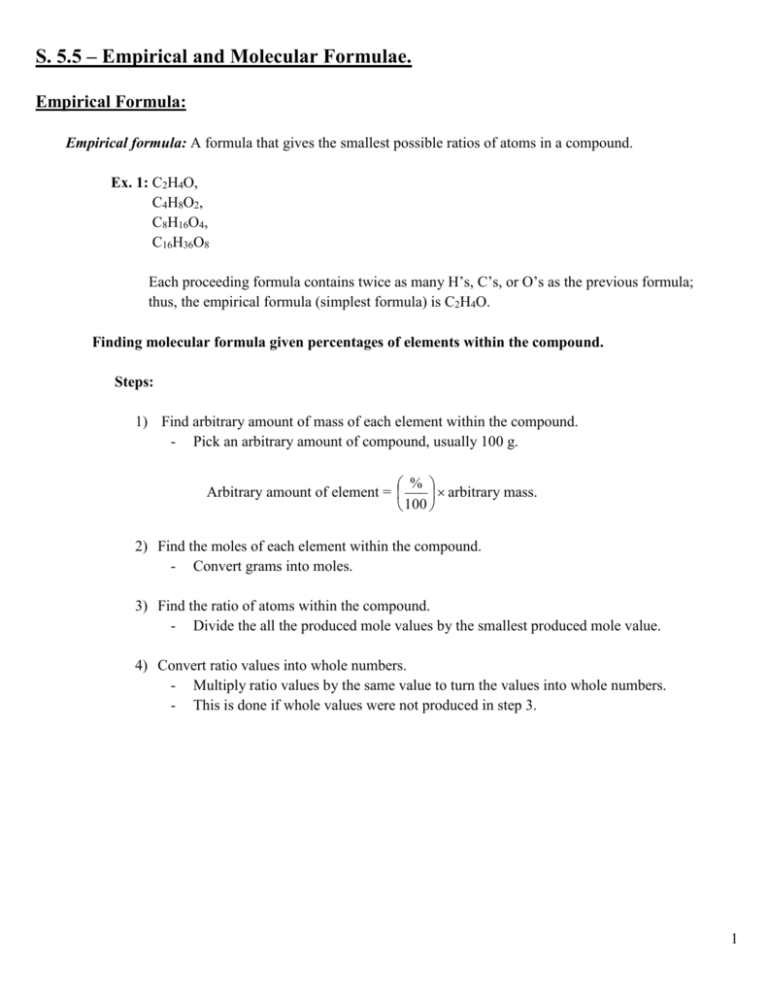
S. 5.5 – Empirical and Molecular Formulae. Empirical Formula: Empirical formula: A formula that gives the smallest possible ratios of atoms in a compound. Ex. 1: C2H4O, C4H8O2, C8H16O4, C16H36O8 Each proceeding formula contains twice as many H’s, C’s, or O’s as the previous formula; thus, the empirical formula (simplest formula) is C2H4O. Finding molecular formula given percentages of elements within the compound. Steps: 1) Find arbitrary amount of mass of each element within the compound. - Pick an arbitrary amount of compound, usually 100 g. % Arbitrary amount of element = arbitrary mass. 100 2) Find the moles of each element within the compound. - Convert grams into moles. 3) Find the ratio of atoms within the compound. - Divide the all the produced mole values by the smallest produced mole value. 4) Convert ratio values into whole numbers. - Multiply ratio values by the same value to turn the values into whole numbers. - This is done if whole values were not produced in step 3. 1 Ex. 1: What is the empirical formula of a compound consisting of 15.9 % B, 84.1 % F. Assume 100.0 g of the compound is taken. Ex. 2: What is the empirical formula of a compound consisting of 21.8 % Mg, 27.9 % P, 50.3 % O. Assume 100.0 g of the compound is taken. Mass of Mg = 21.8 g, Mass of P = 27.9 g, Mass of O = 50.3 g 2 What value to use to create whole numbers? - Look at the first two decimal values. Thirds always end in 0.33 or 0.67 and are multiplied by 3 to create whole values. Quarters always end in 0.25 or 0.75 and are multiplied by 4 to create whole values. Halves end in 0.50 and are multiplied by 2 to create whole values. Question: - Pg. 93, # 46a-j. Molecular Formula: Molecular Formula: The formula with the actual atom values. Ex. 1: Molecular formula is C4H8O2 = 4 C, 8 H, and 2 O OH H C H 3C CH C H OH Where Empirical formula is C2H4O = 2 C, 4 H, and 1 O H C H3C O Two compounds are different. Finding molecular formula. - Determine the multiple of the molecular formula compared to the empirical formula. - Multiply empirical formula by multiple. Steps: 1) Determine the molar mass/empirical masses of the compound. 2) Let N = the whole number multiple of the empirical formula. molar mass 3) Equation is: multiple = N = emperical mass 4) Multiply the Empirical formula atom values by N to produce the molecular formula. 3 Ex. 1: A molecule has an empirical formula of CH2 and a molar mass of 54.06 g. What is the molecular formula? Empirical mass = 18.02 g Ex. 2: A gas has the empirical formula POF3. If 0.350 L of the gas at STP has a mass of 1.62 g, what is the molecular formula of the compound? Empirical mass = 104.0 g. mass Density of gas = = volume Ex. 3: The empirical formula of a compound is SiH3. If 0.0275 mol of a compound has a mass of 1.71 g, what is the compound’s molecular formula? Empirical mass = 31.1 g. Questions. - Pg. 95, # 47, 49, 51, 53, 55. - Quiz next class on S. 5.3 – 5.5. 4


